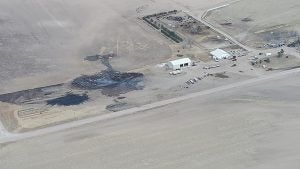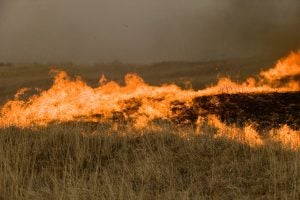We often hear about wildfires spanning large regions in the western U.S. — and the ones we’re often seeing are among the most destructive ever recorded. The government website ready.gov gives guidelines on what to do when there are wildfires in your area, such as to be ready to evacuate, wear a mask outside, and keep windows and doors shut to keep smoke out of the house.
But what happens when there’s livestock involved? If we assume that wildfires will continue to happen in the future, then it would be wise of us to start understanding the effects that wildfires have on production animals.
Researchers at Oregon State University and the University of Idaho have begun to study the impact that wildfires have on cattle.
Juliana Ranches and Jenifer Cruickshank are assistant professors at Oregon State University who have started a three-year study on the effects of wildfires on dairy cattle and their milk production. Ranches and Cruickshank believe that if wildfires are going to keep happening, we better figure out what sort of effect it has on the food system.

In calves, Ranches and Cruickshank are focusing primarily on lung health around exposure to wildfire activity. The team has 16 adult beef and 16 adult dairy cattle that they collect data from. Before smoke exposure they take baseline observations of the animals including a visual inspection and weight, and they analyze blood and milk samples. During smoke events the animals are observed and have blood and milk samples collected every other day. A smoke event is defined as the air quality index being greater than 50. (By comparison, a typical small town in middle American often has an air quality index of between 5 and 17.)
The milk samples from the dairy cows are being analyzed for fat, protein, cortisol levels, blood cell concentrations, immunoglobulins, and anything that can tell a story about the cow’s immune system. There is interest in whether the data can show insights into conception rates, milk production, or the onset of pneumonia at younger ages in calves.
Amy Skibiel and Pedram Rezamand, assistant professors, and Ashly Anderson, a graduate student at the University of Idaho have been collecting data since 2019. Their preliminary results show that in response to a wildfire event, cows are having an inflammatory response, and that milk production is dropping by up to three pounds of production a day.
Milk can absorb flavors easily, but so far no study has been conducted on whether long smoke exposure has changed the flavor profile of milk or not. Cows fed onion or garlic often produce milk that tastes oniony or garlicky, and some milk has a “barnyard” taste to it if the feed has a strong smell.
If smoke from wildfires is able to change the flavor profile of milk, that could have huge implications on dairy processors such as Tillamook in Oregon or Hilmar Cheese in California.
Likewise, a drop in production could hurt the dairy economy. The U.S. exports 16 percent of milk solids produced. California has 1.7 billion dairy cows in the state, producing about 20 percent of U.S. milk. If every Californian cow experienced a three pound drop in production for one lactation, that would be a loss of 1.5 billion pounds of milk in a year. The U.S. produces 218 billion pounds of milk a year, so that loss of three pounds per cow for one lactation is almost 1 percent of milk in the U.S. This may seem insignificant on the surface, but wildfires are not consolidated to California, and they are not getting any smaller.
In addition to livestock being directly affected by wildfires, crops are certainly being affected as well. The Agriculture Climate Network finds that 75 percent of land that wildfires destroy is cropland. When the air is full of smoke, very little light can shine through, inhibiting crops’ growth. Additionally, even a thin covering of ash on plants will physically block the sun from reaching the plants, stopping photosynthesis.

Wildfires pose multiple threats to farmers and livestock. Wildfires are dangerous, and spread at an astonishing pace of over 10 miles per hour, being able to engulf fields of crops or livestock very quickly. The fires raise the temperature in the area, making it harder to grow certain crops and creating more heat-stressed days for livestock. The ash that can smother a land damages facilities and equipment, and it is dangerous to breathe. Farms with open water tubs have to clean them multiple times daily in order to be able to offer animals fresh, clean water.
Wildfires could reshape what farming looks like if they continue to burn ground the way that they are.
Elizabeth Maslyn is a Cornell University student pursuing a career in the dairy industry. Her passion for agriculture has driven her desire to learn more, and let the voices of our farmers be heard.



